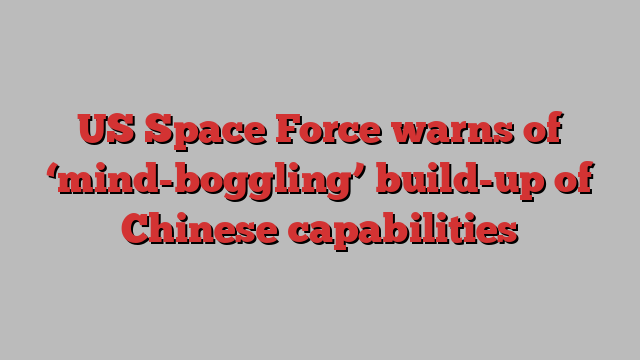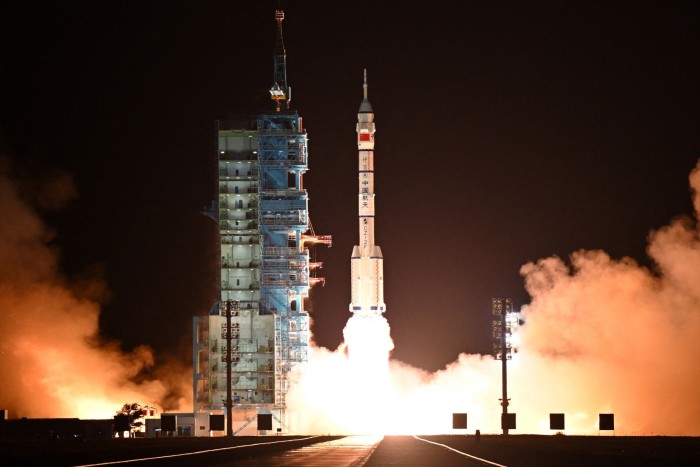
Unlock the US Election Countdown newsletter for free
The stories that matter on money and politics in the race for the White House
The chief of the US Space Force has warned that China is putting military capabilities into space at a “mind-boggling” pace, significantly increasing the risk of warfare in orbit.
“The number of different categories of space weapons that [China has] created and . . . the speed with which they’re doing it is very threatening,” said General Chance Saltzman, head of space operations at the US military’s recently created force tasked with protecting American interests in space.
Saltzman spoke during a tour of Europe to raise awareness about the potential for conflict in space with powers including China and Russia and the need to co-operate with European allies to improve deterrence capabilities.
“One of the reasons you have a space force in the US now is in recognition of the last 20 years, [Russia and China] have developed and demonstrated the ability to conduct war fighting in space,” he said. The Space Force was established in 2019 by then-president Donald Trump, who is vying for re-election next week.
The US military has long been using space-based assets for communications and missile targeting. For China, space has become an increasingly crucial domain in its quest to put one of the US military’s traditional strengths at risk.
Beijing has dismissed US claims its increasingly sophisticated space programme poses any danger to other countries. The foreign ministry accused Washington this year of “repeatedly hyping up China” as a threat as “an excuse for the US to expand its forces in outer space and maintain military hegemony”.

As part of large-scale military reforms started in 2015, Chinese President Xi Jinping combined space, information and cyber warfare operations under the Strategic Support Force, a new arm of the People’s Liberation Army.
In April Xi launched another restructuring that in effect dissolved the SSF and puts its functions under direct control of the military leadership, in a sign that he seeks to enhance space, cyber and information operations.
Both Russia and China have tested satellites with capabilities that include grappling hooks to pull other satellites out of orbit and “kinetic kill vehicles” that can target satellites and long-range ballistic missiles in space.
In May, a senior US defence department official told a House Armed Services Committee hearing that Russia was developing an “indiscriminate” nuclear weapon designed to be sent into space, while in September China made a third secretive test of an unmanned space plane that could be used to disrupt satellites.
The US is far ahead of its European allies in developing military space capabilities but it wanted to “lay the foundations” for the continent’s space forces, Saltzman said. Last year UK Air Marshal Paul Godfrey was appointed to oversee allied partnerships with Nato with the US Space Force — one of the first times that a high-ranking allied pilot has joined the US military.
But Saltzman warned against a rush to build up space forces across the continent.
“It is resource-intensive to separate out and stand up a new service. Even . . . in America where we think we have more resources, we underestimated what it was going to take,” he said.

The US Space Force, which monitors more than 46,000 objects in orbit, has about 10,000 personnel but is the smallest department of the US military. Its officers are known as “guardians”.
The costs of building up space defence capabilities mean the US is heavily reliant on private companies, raising concerns about the power of billionaires in a sector where regulation remains minimal.
SpaceX, led by prominent Trump backer Elon Musk, is increasingly working with US military and intelligence through its Starshield arm, which is developing low Earth orbit satellites that track missiles and support intelligence gathering.
This month, SpaceX was awarded a $734mn contract to provide space launch services for US defence and intelligence agencies.
Despite concerns about Musk’s erratic behaviour and reports that the billionaire has had regular contact with Russian President Vladimir Putin, Saltzman said he had no concerns about US government collaboration with SpaceX.
“I’m very comfortable that they’ll execute those [contracts] exactly the way they’re designed. All of the dealings I’ve had with SpaceX have been very professional,” he said.
Additional reporting by Kathrin Hille in Taipei